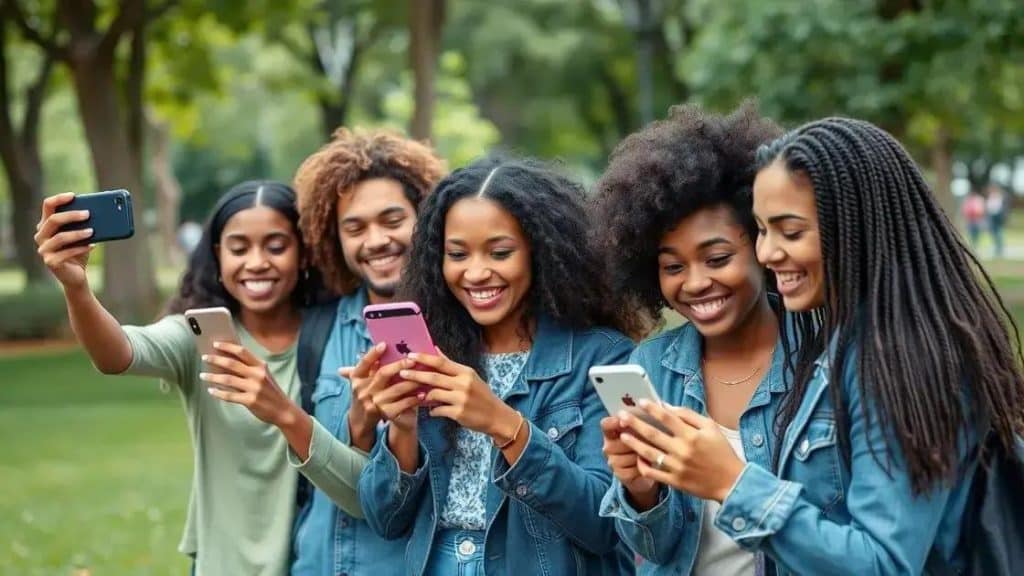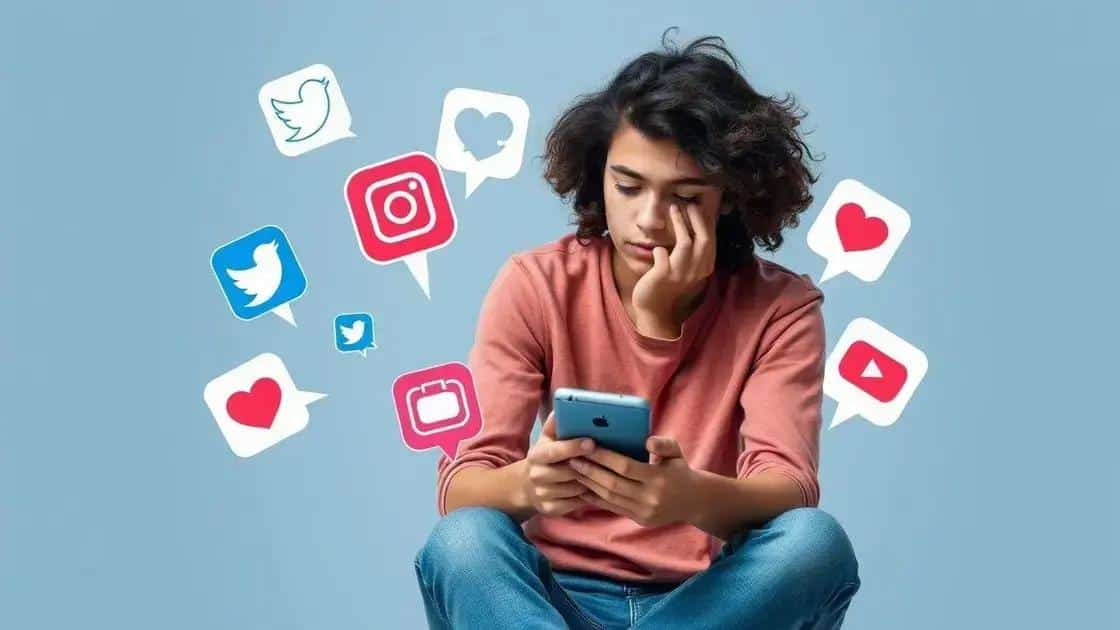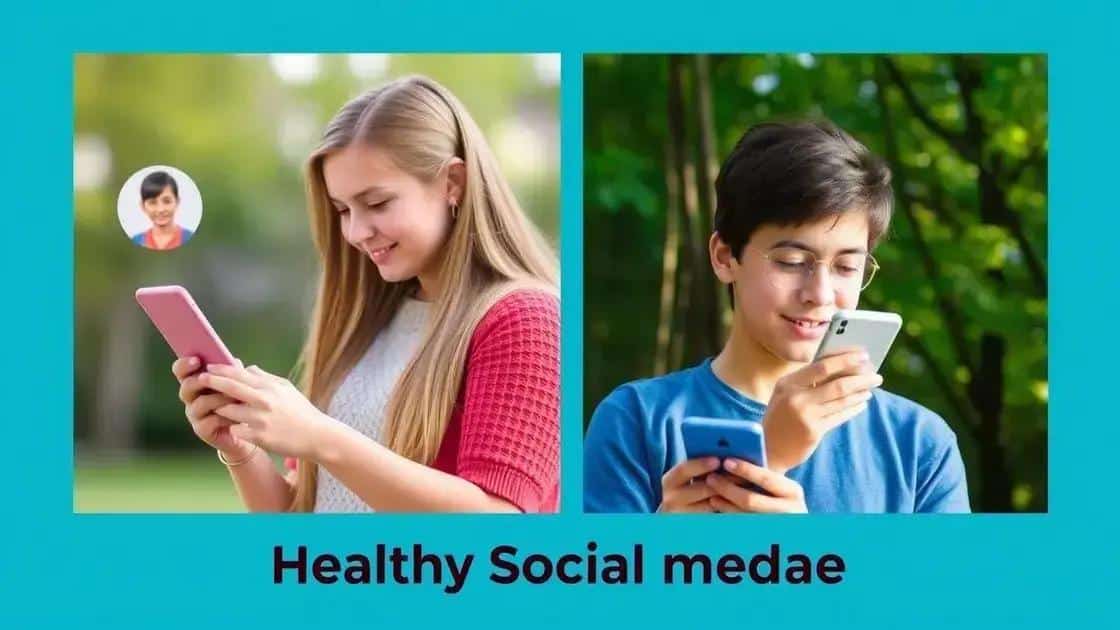Social media impact on youth mental health: a deep dive

Anúncios
The social media impact on youth mental health includes both positive effects, like connection and support, and negative outcomes, such as anxiety and loneliness, necessitating a balanced approach to usage.
The social media impact on youth mental health is a pressing issue that deserves our attention. With so many young people spending significant time online, it’s worth exploring how these platforms affect their emotional well-being. Are they helping or hindering their mental health?
Anúncios
Understanding social media’s role in youth culture
To grasp social media’s role in youth culture, we must first understand how intertwined it has become in their daily lives. For many young people, platforms like Instagram, Snapchat, and TikTok aren’t just tools for interaction; they are central to their identities and social experiences.
Social media platforms influence not only how teenagers communicate but also how they perceive themselves. It can be empowering, allowing them to express their creativity and find communities that support their interests. However, it also has its challenges as it can create pressure to present a perfect life.
Anúncios
The Positive Aspects of Social Media
There are numerous benefits to social media for young individuals:
- Enhances communication and connectivity.
- Provides a platform for creative expression.
- Offers access to diverse perspectives and communities.
Moreover, during times of crisis or uncertainty, social media can serve as a vital source of information and support. For instance, youth often turn to their online networks to share experiences or seek advice during difficult moments.
The Challenges Faced
However, it’s not all positive. Young users also face significant challenges:
- Exposure to cyberbullying and negative comments.
- Unrealistic comparisons with others.
- Potential addiction and excessive screen time.
These challenges can lead to issues like anxiety and depression, making it crucial for young people to develop healthy online habits. Educators and parents play an essential role here, guiding them in navigating these platforms safely.
Understanding social media’s role in youth culture means recognizing both its influence on personal identity and its societal implications. As social media continues to evolve, staying informed about its effects can help ensure that the impacts are beneficial rather than harmful.
The effects of social media on mental well-being

The effects of social media on mental well-being are significant and multifaceted. While social platforms can foster connection, they also contribute to issues like anxiety and depression among young users.
Social media can enhance a sense of belonging, especially for those who may feel isolated in their daily lives. Through sharing experiences and engaging in communities, teens gain access to support. But this connection can have a dark side.
Negative Impacts of Social Media
Many young people experience negative emotions related to social media usage:
- Feelings of inadequacy based on others’ highlight reels.
- Increased fear of missing out (FOMO).
- Higher rates of loneliness despite being connected.
When individuals constantly compare themselves to curated online personas, it can lead to dissatisfaction and low self-esteem. This continuous feedback loop can make feelings of insecurity more prominent.
Positive Contributions to Mental Health
Despite the downsides, social media can provide positive outcomes:
- Access to mental health resources and online counseling.
- Opportunities to raise awareness about mental health issues.
- Supportive online communities for sharing struggles.
For some, platforms can create spaces where they feel comfortable discussing their mental health openly. The ability to find others with similar experiences can be beneficial and therapeutic.
Balancing these positive and negative effects is paramount. Encouraging young people to use social media mindfully can lead to healthier habits and better mental well-being. By promoting positive interactions and reducing screen time, we can shape a more supportive environment for mental health in the digital age.
Balancing online presence and real-life interactions
Balancing online presence and real-life interactions is crucial for maintaining mental health, especially for young people. With the rise of social media, finding harmony between the virtual and physical worlds can be challenging.
Many youths spend hours interacting online, which can lead to a disconnect from real-life relationships. While it’s easy to connect with friends digitally, face-to-face interactions often provide deeper emotional support and understanding.
Importance of Real-Life Connections
Building strong, in-person relationships is essential for several reasons:
- Face-to-face interactions foster deeper emotional bonds.
- Real-life conversations help improve social skills.
- Physical presence can reduce feelings of loneliness.
Engaging in real-life activities, such as joining clubs or participating in sports, allows teens to forge connections that are often more meaningful than those formed online.
Strategies for Balancing Both Worlds
To strike a balance, young people can adopt practical strategies:
- Set aside specific times for social media use.
- Prioritize in-person meetups over digital conversations.
- Engage in hobbies that promote offline interactions.
By implementing these strategies, they can create a healthier relationship with both online and offline worlds. It’s about finding a manageable way to enjoy social media while still valuing the unique benefits of real-life connections.
This balance is vital for emotional well-being. Encouraging youths to reflect on their online habits can lead to more fulfilling relationships both on and off-screen.
Strategies to promote healthy social media use

Promoting healthy social media use is essential for the well-being of young users. As social media becomes a larger part of everyday life, implementing simple strategies can make a significant difference.
The first step is to establish clear boundaries around social media use. Young people should consider setting specific times for checking apps to reduce excessive scrolling, which can interfere with daily activities and relationships. It’s important to prioritize tasks and make offline activities a priority.
Understanding Your Usage
Keeping track of time spent on social media can help users become more aware of their habits:
- Use screen time tracking apps to monitor usage.
- Reflect on how social media affects your mood.
- Identify when and why you feel the urge to check your phone.
Becoming aware of these patterns can promote healthier behaviors. Understanding how social media impacts emotions can encourage users to take breaks when needed.
Engaging Mindfully
Engaging on social media should be a mindful process:
- Focus on positive interactions, such as uplifting conversations.
- Unfollow accounts that lead to negative feelings.
- Participate in online groups that promote mental well-being.
Connecting with others who share similar positive goals can enhance the social media experience. This helps create a supportive online environment that fosters positivity and growth.
By encouraging young users to adopt these strategies, parents and educators can aid in developing a balanced approach to social media use, ensuring that it enriches rather than harms their mental health.
impact of social media on youth mental health is essential. While it can provide a platform for connection and self-expression, it also brings challenges that can affect well-being. By promoting healthy social media use, encouraging real-life interactions, and maintaining balance, both young people and their mentors can cultivate a positive online experience. Together, we can help navigate the digital landscape more effectively, ensuring that social media fosters healthy relationships and enhances mental wellness. Remember, it’s not just about limiting use but using these platforms mindfully to enrich daily life and connections.
FAQ – Frequently Asked Questions about Social Media Impact on Youth Mental Health
What are the main effects of social media on youth mental health?
Social media can lead to both positive and negative effects, including enhanced communication and feelings of connection, but also anxiety, depression, and loneliness.
How can I promote healthy social media use among young people?
Encouraging specific screen time limits, fostering positive interactions, and prioritizing real-life engagements can help promote healthier habits.
Why is balancing online and offline interactions important?
Balancing online and offline interactions is crucial for emotional well-being, as in-person relationships can provide deeper support and reduce feelings of isolation.
What strategies can help minimize negative feelings related to social media?
Strategies include tracking social media usage, unfollowing negative accounts, and engaging in hobbies that promote offline interactions.





